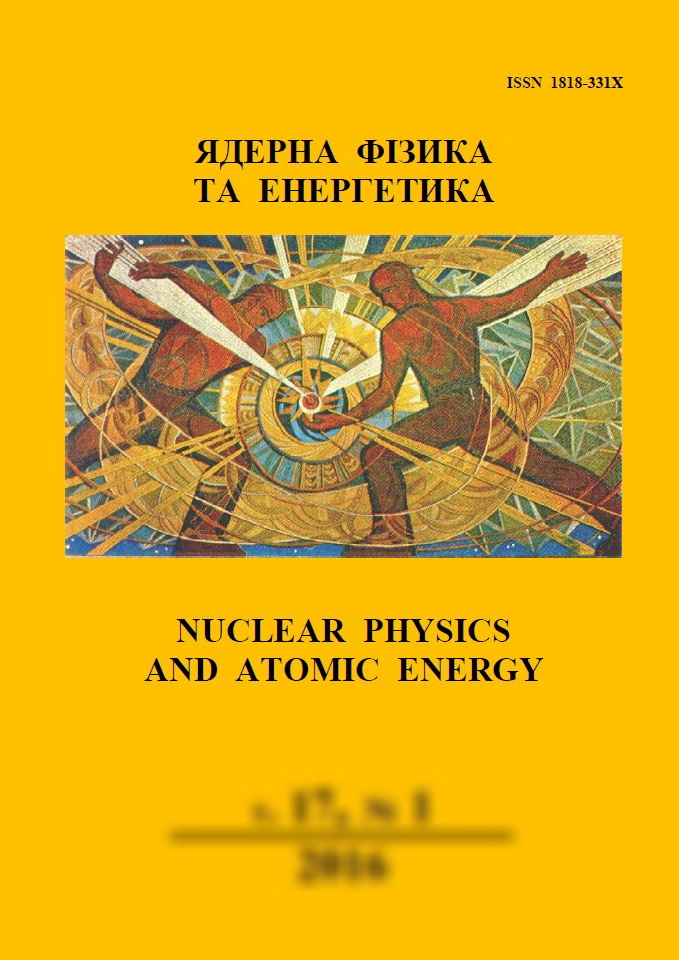 |
ßäåðíà ô³çèêà òà åíåðãåòèêà
Nuclear Physics and Atomic Energy
ISSN:
1818-331X (Print), 2074-0565 (Online)
Publisher:
Institute for Nuclear Research of the National Academy of Sciences of Ukraine
Languages:
Ukrainian, English, Russian
Periodicity:
4 times per year
Open access peer reviewed journal
|
Nucl. Phys. At. Energy 2017, volume 18, issue 2, pages 151-160.
Section: Nuclear Physics.
Received: 28.03.2017; Accepted: 12.10.2017; Published online: 22.11.2017.
 Full text (en)
Full text (en)
https://doi.org/10.15407/jnpae2017.02.151
Nuclear binding energy and density distribution of Pb isotopes in a Skyrme - Hartree - Fock method
Y. Yulianto*, Z. Su’ud
Department of Physics, Bandung Institute of Technology, Bandung, Indonesia
*Corresponding author. E-mail address:
yacyulianto@gmail.com
Abstract:
In this study, nuclear ground-state properties of spherical nuclei, such as the total energy, nucleon local density, and nucleon local potential of Pb isotopes (especially 204-214Pb) are investigated by using Hartree - Fock method. The calculations have been performed by using Skyrme set parameters, especially SLy4, SkM*, Zσ, and SIII set parameters. The calculation results have been compared to the related experiment results and the calculation results of the other researchers. All parameters used in this study are in good agreement with the results of the related experiments and the other researchers. In Pb nucleus, it is also obtained from this study that the total energy, mass radius, neutron radius, neutron skin thickness, neutron density, neutron density width, proton potential depth, and proton potential width increase accordingly with the increase of neutron number. In other hand, proton density and neutron potential decrease accordingly with the increase of neutron number. The increase of neutron number has minimum effect to the widths of proton density and neutron potential.
Keywords:
Hartree - Fock, local density, nuclear binding energy, Pb isotopes, Skyrme interaction.
References:
1. Z. Su’ud et al. Desain Study of Pb-Bi Cooled Fast Reactors with Natural Uranium as Fuel Cycle Input Using Special Shuffling Strategy in Radial Direction. Advanced Materials Research 772 (2013) 530.
http://doi.org/10.4028/www.scientific.net/AMR.772.530
2. G.L. Khorasanov, A.I. Blokhin. Some Advantages in Using Lead-208 as Coolant for Fast Reactors and Accelerator Driven Systems. In: Application of Stable Lead Isotope Pb-208 in Nuclear Power Engineering and its Acquisition Techniques. Ed. by G.L. Khorasanov (New York: Nova Science Pub Inc., 2013) p. 1.
Book
3. D. Vautherin, D.M. Brink. Hartree - Fock calculation with Skyrme’s interaction. I. Spherical nuclei.
Phys. Rev. C 5 (1972) 626.
https://doi.org/10.1103/PhysRevC.5.626
4. J. Friedrich, P.-G. Reinhard. Skyrme-force parametrization: Least-squares fit to nuclear ground-state properties. Phys. Rev. C 33 (1986) 335.
https://doi.org/10.1103/PhysRevC.33.335
5. J. Dobaczewski et al. Nuclear shell structure at particle drip lines. Phys. Rev. Lett. 72 (1994) 981.
https://doi.org/10.1103/PhysRevLett.72.981
6. E. Tel et al. Investigation of the nuclear structure of the Be, Cr, and Cu isotopes. Annals of Nuclear Energy 36 (2009) 1333.
https://doi.org/10.1016/j.anucene.2009.07.002
7. E. Tel et al. Calculation of Radii and Density of 7-19B Isotopes Using Effective Skyrme Force. Commun. Theor. Phys. 49 (2008) 696.
https://doi.org/10.1088/0253-6102/49/3/37
8. A.A. Alzubadi, Z.A. Dakhil, S.T. Aluboodi. Microscopic study of nuclear structure for some Zr-isotopes Using Skyrme-Hartree-Fock Method. Journal of Nuclear and Particle Physics 4(6) (2014) 155.
http://doi.org/10.5923/j.jnpp.20140406.01
9. T.H.R. Skyrme. The effective nuclear potential. Nucl. Phys. 9 (1959) 615.
https://doi.org/10.1016/0029-5582(58)90345-6
10. P.-G. Reinhard. The Skyrme - Hartree - Fock model of the nuclear ground state. In: Computational Nuclear Physics. I. Nuclear Structure. Ed. by K. Langanke, J. Maruhn, S.E. Koonin (Berlin: Springer-Verlag, 1991) p. 28.
https://doi.org/10.1007/978-3-642-76356-4_2
11. H. Aytekin, D. Demirbag. Investigation of the nuclear properties of 181Ta and 182,183,184,186W structural materials. Indian Journal Phys. 87 (2013) 487.
https://doi.org/10.1007/s12648-013-0253-0
12. E. Chabanat et al. A Skyrme parametrization from subnuclear to neutron star densities. Nucl. Phys. A 627 (1997) 710.
https://doi.org/10.1016/S0375-9474(97)00596-4
13. J. Bartel et al. Towards a better parametrization of Skyrme-like effective forces: A critical study of the SkM force. Nucl. Phys. A 386 (1982) 79.
https://doi.org/10.1016/0375-9474(82)90403-1
14. M. Beiner et al. Nuclear ground-state properties and self-consistent calculations with the Skyrme interaction (I). Spherical description. Nucl. Phys. A 238 (1975) 29.
https://doi.org/10.1016/0375-9474(75)90338-3
15. J. Erler, P. Klupfel, P.-G. Reinhard. Self-consistent nuclear mean-field models: Example Skyrme - Hartree - Fock. J. Phys. G: Nucl. Phys. 38 (2011) 033101.
https://doi.org/10.1088/0954-3899/38/3/033101
16. H. Aytekin, E. Tel, R. Baldik. Investigation of the Ground State Features of Some Excotic Nuclei by Using Effective Skyrme Interaction. Turk J. Phys. 32 (2008) 181.
Article
17. H. Gu et al. Slater approximation for Coulomb exchange effects in nuclear covariant density functional theory. Phys. Rev. C 87 (2013) 041301.
https://doi.org/10.1103/PhysRevC.87.041301
18. E. Tel, A. Aydin. Investigation of Lead Target Nuclei Used on Accelerator-Driven Systems for Tritium Production. J. Fusion Energy 31 (2012) 73.
https://doi.org/10.1007/s10894-011-9433-0
19. W.D. Myers, W.J. Swiatecky. Average Nuclear Properties. Ann. Phys. 55 (1969) 395.
https://doi.org/10.1016/0003-4916(69)90202-4
20. M. Wang et al. The AME2012 atomic mass evolution (II). Tables, graphs and references. Chinese Physics C 36 (2012) 1603.
https://doi.org/10.1088/1674-1137/36/12/003
21. I. Angeli, K.P. Marinova. Table of experimental nuclear ground state charge radii: An update. Atomic Data and Nuclear Data Tables 99 (2013) 69.
https://doi.org/10.1016/j.adt.2011.12.006
22. G.-Q. Li. A systematic study of nuclear properties with Skyrme forces. J. Phys. G: Nucl. Part. Phys. 17 (1991) 1.
https://doi.org/10.1088/0954-3899/17/1/002
